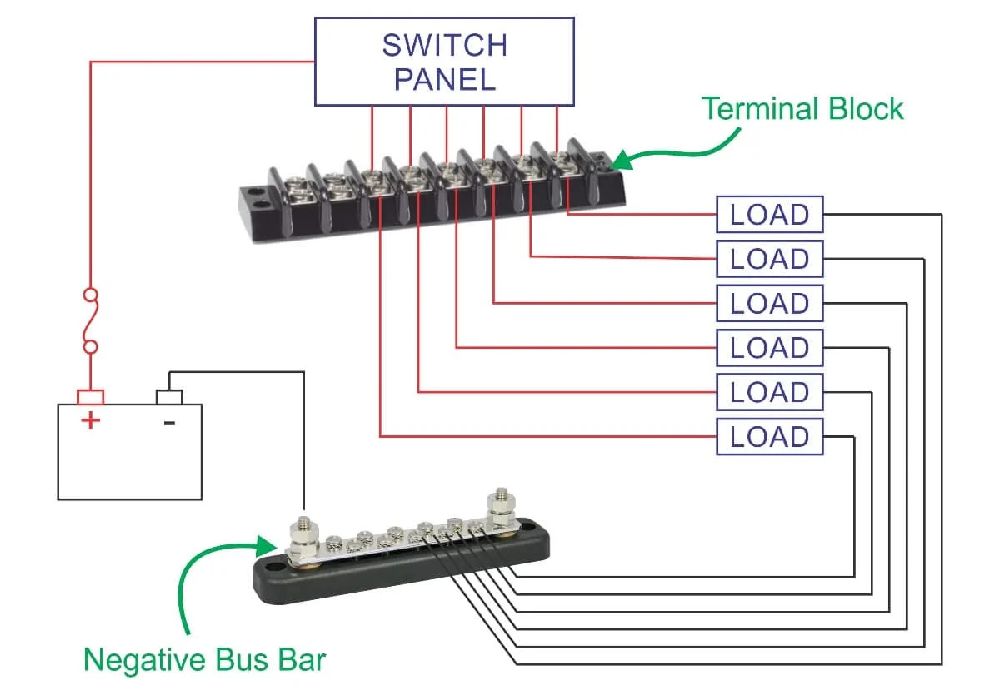Terminal blocks play a crucial role in electrical and electronic systems by offering a reliable and organized method for interconnecting wires and cables. These units act as pivotal hubs for electrical conduits, simplifying the setup, upkeep, and problem-solving processes.

Types of Terminal Blocks
Screw Terminal Blocks
Screw terminal blocks function by using screws to secure wires in place, establishing a reliable connection. These components find extensive use across various applications and are known for their straightforward design and dependable performance.
Spring Terminal Blocks
Spring terminal blocks are equipped with spring-loaded clamps that securely hold wires without the necessity of screws. These blocks facilitate rapid and tool-free wire connections, rendering them suitable for scenarios that demand frequent adjustments.
Barrier Terminal Blocks
Barrier terminal blocks feature insulated barriers that separate terminals, enhancing safety measures by averting unintended contact between wires, particularly in high-voltage scenarios..
DIN Rail Terminal Blocks
DIN rail terminal blocks are specifically engineered for attachment to DIN rails, providing an efficient way to arrange and link wires within control panels and industrial settings.
Components of a Terminal Block
Components Comprising Terminal Blocks
- The body is the primary casing that accommodates the terminals and offers structural reinforcement.
- Contacts: Metal parts that make electrical contact with wires.
- Clamps are devices utilized to fasten wires securely, employing mechanisms like screws or spring-operated clamps.
- Insulators refer to substances that inhibit the flow of electricity between connectors and the surface on which they are mounted.
- Identification tags are utilized as labels or markers to indicate connections, simplifying maintenance and problem-solving processes.
How Do Terminal Blocks Work
Terminal blocks function by establishing a dependable and safe link between wires. Upon inserting a wire into a terminal, the clamp system exerts pressure to form a secure hold, guaranteeing efficient electrical connectivity.
Advantages of Using Terminal Blocks
Ease of Installation
Terminal blocks streamline the wiring procedure, facilitating speedy and effective setup without requiring soldering or specific instruments.
Flexibility
They offer the ability to conveniently reorganize or extend wiring setups, granting adaptability to meet evolving system needs.
Maintenance
Terminal blocks enable convenient access to specific connections, simplifying maintenance activities like examination, testing, and substitution.
Safety
Rephrase Terminal blocks, when appropriately insulated and labeled, are significant in promoting safety by minimizing potential electrical dangers and facilitating the clear identification of circuits.
Applications of Terminal Blocks
Versatile Applications of Terminal Blocks Across Diverse Industries
- Industrial Automation: Industrial automation covers a range of technologies, including Programmable Logic Controllers (PLCs), motor control systems, and sensor integration.
- Power Distribution: Panels for distribution, devices for switching circuits, and protective equipment.
- Control Panels: Control Panels refer to control cabinets, junction boxes, and instrument panels.
- HVAC Systems: Heating, ventilation, and air conditioning (HVAC) systems comprise thermostats and actuators
Choosing the Right Terminal Block
Key Considerations for Choosing the Right Terminal Block
- Voltage Rating: Voltage rating ensures alignment with the system's voltage to avert electrical breakdowns.
- Present Evaluation: Competent in managing the anticipated electrical flow without experiencing excessive heat.
- Wire Gauge: Ensuring appropriate wire size and type to optimize electrical conductivity.
- Environmental Conditions: Environmental conditions refer to the ability to withstand various elements such as temperature, moisture, and vibration.
Installation Tips
Properly installing terminal blocks is essential to ensure peak performance and safety. Here are some recommendations to consider:
- Implementing precise methods in wire handling: Verifying accurate removal, arrangement, and conclusion of wires.
- Properly applying tightening torque is crucial to ensuring secure connections without causing harm to conductors.
- Insulation involves the utilization of insulating barriers and covers to shield against unintended contact.
- Identification Labeling: Ensuring clear and precise labelling of connections to facilitate identification during installation and maintenance.
Maintenance and Troubleshooting
Consistent upkeep of terminal blocks is essential to guarantee their dependability and safety. Typical responsibilities comprise:
- Regular Inspections: Verifying loose links, indications of deterioration, and harm.
- Cleaning: Cleaning involves the elimination of dust, debris, and oxidation to uphold optimal electrical connectivity.
- Replacement: Substituting worn or defective terminal blocks is essential to avert malfunctions.
- Common Issues and Solutions: Dealing with inadequate connections, rust, and insulation deterioration without delay.
Future Trends in Terminal Block Technology
Advances in terminal block technology aim to improve performance, functionality, and connectivity. Potential future developments could involve:
- Miniaturization: Creating smaller and more condensed configurations suitable for limited-space applications.
- Incorporation: The assimilation of supplementary functions like surge protection and communication features.
- Smart features: Incorporation of Internet of Things (IoT) connectivity and remote surveillance to elevate supervision and diagnostic capabilities.
Conclusion
Terminal blocks are essential components in electrical and electronic systems, serving as a dependable and adaptable method for wire connections. They come in various configurations to accommodate diverse needs and uses, offering convenience, versatility, and safety. Making the right choices, performing proper installations, and conducting regular maintenance to uphold high-performance standards and durability is crucial.
FAQs
- Is it permissible to utilize terminal blocks for varying wire sizes?
Utilizing terminal blocks designated for particular wire gauges is crucial to guarantee adequate contact and safety. Employing terminal blocks interchangeably for different wire sizes can result in inadequate connections and potential safety risks.
- Is it necessary to perform routine maintenance on terminal blocks?
Indeed, it is advised to conduct regular checks and maintenance on terminal blocks to maintain their efficiency and safety. Tasks involve examining the connections for stability, conducting cleaning procedures, and replacing worn-out parts when necessary.
- Is blending various categories of terminal blocks within a single application permissible?
Although combining terminal block varieties is plausible, verifying compatibility and guaranteeing adequate insulation to avert electrical risks is crucial.
You Might Also Like: How Do You Calculate The Error Of A Voltage Divider?








